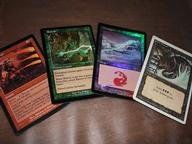Quiz Answer Key and Fun Facts
1. What is the common trait of the following five cards?
Black Vise
Dragon Whelp
Frozen Shade
Mox Jet
Tranquility
2. What is the common trait of the following five cards?
Alpha Tyrranax
Elvish Rejuvenator
Ghazban Ogre
Kavu Primarch
Quilled Wolf
3. What is the common trait of the following five cards?
Blinkmoth Nexus
Crystal Vein
Maze of Shadows
Quicksand
Springjack Pasture
4. What is the common trait of the following six cards?
Balance
Dawn to Dusk
Empty City Ruse
Excoriate
Gaze of Justice
Vanquish the Foul
5. What is the common trait of the following five cards?
Ajani Goldmane
Chandra Ablaze
Freyalise, Llanowar's Fury
Garruk, Apex Predator
Vraska, Golgari Queen
6. What is the common trait of the following six cards?
Bravado
Claws of Valakut
Conquer
Dizzying Gaze
Genju of the Spires
Paroxysm
7. What is the common trait of the following four cards?
Agrus Kos, Wojek Veteran
Anax and Cymede
Bruna, Light of Alabaster
Garza Zol, Plague Queen
8. What is the common trait of the following six cards?
Earwig Squad
Eviscerator
Juzam Djinn
Phyrexian Negator
Spined Fluke
Tombstalker
9. What is the common trait of the following five cards?
Dazzling Ramparts
Nivix Barrier
Psychic Membrane
Quicksilver Wall
Wall of Junk
10. What is the common trait of the following seven cards?
Absorb
Capsize
Deny Existence
Jeskai Charm
Rhystic Lightning
Turf Wound
Vanquish
Source: Author
WesleyCrusher
This quiz was reviewed by FunTrivia editor
agony before going online.
Any errors found in FunTrivia content are routinely corrected through our feedback system.
